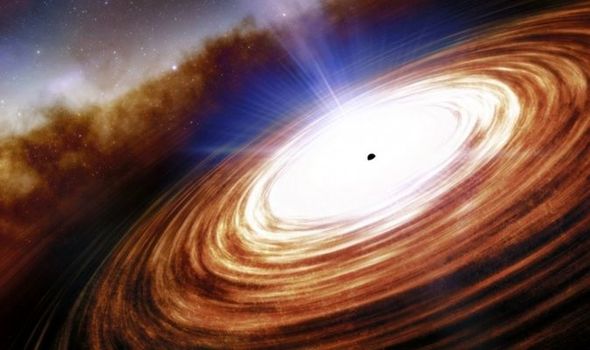Researchers from the University of Arizona have spotted a quasar 13.03 billion light-years from Earth. It is the most distant quasar to have ever been discovered, having formed just 670 million years after the Big Bang. That means the galaxy has been there for all but five percent of the entire history of the Universe.
The quasar in question is known as J0313-1806, and it is also the first of its kind to show evidence of an out-flowing wind of super-heated gas escaping from the area around the black hole at a fifth of the speed of light.
The new observations also show an intense activity of star formation in the galaxy.
The black hole in its centre is also a true Goliath, having a mass of 1.6 billion times the Sun.
However, this is the first of its kind so early in the Universe to be discovered, and provides an insight into how the earliest black holes helped influence surrounding galaxies.
Study lead author Feige Wang, a Hubble Fellow at the University of Arizona’s Steward Observatory, said: “This is the earliest evidence of how a supermassive black hole is affecting its host galaxy around it.
“From observations of less distant galaxies, we know that this has to happen, but we have never seen it happening so early in the universe.”
Black holes typically form when a huge star explodes, creating a tear in the fabric of space-time.
Over time, as the infant black holes gobble up all matter that surrounds them, they can grow and become supermassive black holes.
However, what is surprising is that the supermassive black hole formed so soon after the Big Bang when theoretically there was not enough matter to create one.
Calculations from the University of Arizona show that even if the black hole formed 100 million years after the Big Bang, it would need to have been born from the collapse of a star with at least 10,000 solar masses.
Co-author Xiaohui Fan, Regents Professor and associate head of the University of Arizona Department of Astronomy, said: “This tells you that no matter what you do, the seed of this black hole must have formed by a different mechanism.
“In this case, one that involves vast quantities of primordial, cold hydrogen gas directly collapsing into a seed black hole.
“In order for the black hole to have grown to the size we see with J0313-1806, it would have to have started out with a seed black hole of at least 10,000 solar masses, and that would only be possible in the direct collapse scenario.”
The research published in the journal Astrophysical Journal Letters said that the black hole at the centre of J0313-1806 is digesting the equivalent of 25 Suns each year, “which is thought to be the main reason for its high-velocity hot plasma wind blowing into the galaxy around it at relativistic speed.”
However, the galaxy produces more than 200 solar masses every year – dwarfing the average of one per year in the Milky Way.
Prof Wang said: “This is a relatively high star formation rate, similar to that observed in other quasars of similar age, and it tells us the host galaxy is growing very fast.
Prof Fan added: “These quasars presumably are still in the process of building their supermassive black holes.
“Over time, the quasar’s outflow heats and pushes all the gas out of the galaxy, and then the black hole has nothing left to eat anymore and will stop growing.
“This is evidence about how these earliest massive galaxies and their quasars grow.”






